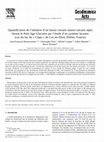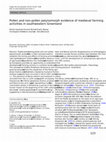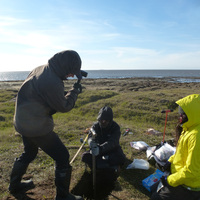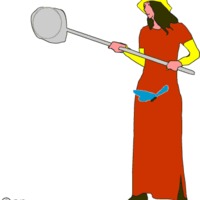Papers by Hervé Richard

Geodinamica Acta, 2002
Les mesures de lˈérosion actuelle donnent des résultats hétérogènes en fonction des méthodes util... more Les mesures de lˈérosion actuelle donnent des résultats hétérogènes en fonction des méthodes utilisées. Cet article propose une approche de l’érosion durant le Petit Age Glaciaire par l’analyse quantitative des matériaux détritiques piégés dans un lac de barrage. Ce remplissage est reconnu par deux forages et ces observations ponctuelles sont complétées par une étude en sismique réflexion fournissant une estimation fiable de la géométrie du remplissage lacustre. La production sédimentaire est calculée à partir des trois données nécessaires : (1) la surface du bassin producteur, (2) la durée de fonctionnement du système et (3) le volume de sédiments piégés. A partir des trois variables déterminées, nous proposons un taux de production sédimentaire détritique de 1846 ± 145 tonnes/km2/an, ce qui représente une dénudation moyenne de 0,68 ± 0,05 mm/an. L’importance d’un forçage hydro-climatique et anthropique sur la production sédimentaire correspondante au cours du Petit Age Glaciaire est soulignée par cette étude.Measurements of present-day erosion may give heterogeneous results according to the methods used. This article proposes an approach to erosion during the Little Ice Age by the quantitative analysis of detritical materials trapped in a dammed lake. This infill is recognized through two drillings, and these specific observations are supplemented by a seismic reflexion survey which provided a reliable estimate of the geometry of the lake infill. The sedimentary production is calculated from three pieces of data: (1) the surface of the drainage area, (2) duration of the lake system activity and (3) the volume of trapped sediments. From the three determined variables, we propose a detritical production sedimentary rate of 1846 ± 145 tonnes/km2/year, which represents a mean denudation of 0.68 ± 0.05 mm/year. The importance of a hydro-climatic and anthropic forcing on the sedimentary production during the Little Ice Age is emphasized by this study.

Radiocarbon dating, pollen and non-pollen palynomorph analyses from a lake core were used to esta... more Radiocarbon dating, pollen and non-pollen palynomorph analyses from a lake core were used to establish the timing and effects of farming activities around Lake Igaliku, Eastern Settlement, Greenland. The absence of agro-pastoral impact before the medieval colonization by Europeans provides an opportunity to understand the development of farming activity in a pristine landscape. The results show that the first phase of clearance and grazing pressure, without the expansion of the Norse apophyte (native plant, in habitats created by humans) Rumex acetosa type, could have occurred in the 9-10th century A.D. The presence of Norse settlers and livestock is clearly recorded from the 11-12th century A.D. with increasing frequencies of the Norse apophytes Rumex acetosa type and Ranunculus acris type, and coprophilous fungi. This colonization phase is followed by a period of decreasing human impact at the beginning of the 14th century, with a decrease in weeds, apophytes and coprophilous fungi suggesting a reduced grazing pressure. The regrowth of Salix and Betula and the disappearance of anthropogenic indicators except Rumex acetosa type between the 15th and 18th century demonstrate the abandonment of the settlement, until the development of contemporary agriculture in the 20th century.
Quaternaire, 1995
A landslide dammed the upper Doubs valley around 12 ka BP forming a lake that has now been filled... more A landslide dammed the upper Doubs valley around 12 ka BP forming a lake that has now been filled to 9/10ths of its original volume. Sediments from the enclosing basin reveal three phases. - 12 to 9 ka BP, exclusively detntal material from mechanical erosion. - 9 to 6 ka BP, material ...
Lacustrine deposits from Lake Igaliku, South Greenland (N61°00'22'', W45°26'28... more Lacustrine deposits from Lake Igaliku, South Greenland (N61°00'22'', W45°26'28'') were studied to investigate subarctic Holocene climate history. Analyses of the well dated sediment sequence used high-resolution grain size analysis, high-resolution geophysical (MSCL) and geochemical core scanning (XRF core scanner), X-ray radiography, DRX mineralogy, and organic geochemistry. The 4 meters long sequence recovered from Lake Igaliku comprises the entire lake history
Comptes Rendus De L Academie Des Sciences Serie Ii Fascicule A-sciences De La Terre Et Des Planetes, 1997
The nature and the geometry of the infilling accumulated in the basin of Lake Lautrey, Central Ju... more The nature and the geometry of the infilling accumulated in the basin of Lake Lautrey, Central Jura (France), have been identified from 35 cores. A millimetric ash layer was visible to the naked eye in 21 of the cores located in the deeper parts of the basin, Palynological analyses indicate that the tephra deposition occurred before the Allerød termination. Mineralogical
Comptes Rendus Biologies, 2010
This article presents a 241cm long sediment record documenting the vegetation history using polle... more This article presents a 241cm long sediment record documenting the vegetation history using pollen and non-pollen palynomorphs recovered from the Fénay marsh in Burgundy (Dijon area – France). The pollen and non-pollen palynomorphs (NPP) record largely reflects intensive human influence (clearing, cultivation and grazing) on the surrounding area from the Late Bronze Age and Hallstatt period. La Tène period is
Geodinamica Acta, 2002
Measurements of present-day erosion may give heterogeneous results according to the methods used.... more Measurements of present-day erosion may give heterogeneous results according to the methods used. This article proposes an approach to erosion during the Little Ice Age by the quantitative analysis of detritical materials trapped in a dammed lake. This infill is recognized through two drillings, and these specific observations are supplemented by a seismic reflexion survey which provided a reliable estimate
Gallia, Jan 1, 2006
Abstract. The conclusions from the research project in the Laigne valley show the relevance of th... more Abstract. The conclusions from the research project in the Laigne valley show the relevance of the geoarchaeological approach conducted on two scales of investigation. The first, over the entire alluvial plain, allows general data to be collected which characterise the specific functions of each catchment basin during the Holocene period : determination of sedimentary sequences, evolution of vegetation and phases of human occupation. The second is a geoarchaeological approach on the scale of a test site : it demonstrates and dates as precisely as possible interactions between natural events and human activities which reveal changes to the entire catchment basin.
Quaternary International, 2009
Pollen analyses of three sediment cores performed on the archaeological lake dwellings of Chindri... more Pollen analyses of three sediment cores performed on the archaeological lake dwellings of Chindrieux and Tresserve (Savoie, France), on the eastern shore of Lake Bourget, enable the reconstruction of vegetation history and human impact during the Bronze Age. Results ...
Quaternaire, 2000
Le Tardiglaciaire du massif jurassien, perçu par les analyses polliniques, est passé du découpage... more Le Tardiglaciaire du massif jurassien, perçu par les analyses polliniques, est passé du découpage classique en cinq phases (Dryas ancien, Bølling, Dryas moyen, Allerød, Dryas récent) à une partition plus simplifiée où le Dryas ancien et le Dryas récent encadrent une phase climatiquement ...
Quaternary Science Reviews, 2011
One lake and three peat bogs from the Lourdes glacial basin (France) were used for macrocharcoal ... more One lake and three peat bogs from the Lourdes glacial basin (France) were used for macrocharcoal analyses and fire frequency reconstruction over the entire Holocene (11700 years). The chronology was based upon thirty-three 14C AMS dates. Comparison of the distribution of both ...
Comptes Rendus …, 2008
... Presented by Georges Pédro. Aurélie Leroux a , Corresponding Author Contact Information , E-m... more ... Presented by Georges Pédro. Aurélie Leroux a , Corresponding Author Contact Information , E-mail The Corresponding Author , Vincent Bichet a , Anne-Véronique Walter-Simonnet a , Michel Magny a , Thierry Adatte b , Émilie Gauthier a , Hervé Richard a and Agnès Baltzer c. ...
Vegetation History and …
Radiocarbon dating, pollen and non-pollen palynomorph analyses from a lake core were used to esta... more Radiocarbon dating, pollen and non-pollen palynomorph analyses from a lake core were used to establish the timing and effects of farming activities around Lake Igaliku, Eastern Settlement, Greenland. The absence of agro-pastoral impact before the medieval ...
Planetary and Space Science, 1998
The study of the deep interior of Mars suffers from the very limited amount of data available, pa... more The study of the deep interior of Mars suffers from the very limited amount of data available, particularly seismological data. The objective of the OPTIMISM seismic experiment, lost with the failure of the Mars 96 mission, was to perform a seismic reconnaissance of Mars, to constrain the level of martian seismic noise and its level of seismicity. The seismometer was
Papers - Co author by Hervé Richard

Vegetation History and Archaeobotany, 2007
Interdisciplinary research was carried out in mid-level mountain areas in France with the aim of ... more Interdisciplinary research was carried out in mid-level mountain areas in France with the aim of documenting historical mining and smelting activities by means of pollen and geochemical analyses. These investigations were made on cores collected in French peatlands in the Morvan (northern Massif Central), at Mont Lozère (southern Massif Central) and in the Basque Country (Pyrénées). Different periods of mining were recognised from Prehistory to modern times through the presence of anthropogenic lead in peat. Some of these were already known from archaeological dates or historical archives, especially for mediaeval and modern periods. However prehistoric ancient mining activities, as early as the Middle Bronze Age (ca. 1700 b.c.), were also discovered. They had all led to modifications in plant cover, probably related in part to forest clearance necessary to supply energy for mining and smelting.







Uploads
Papers by Hervé Richard
Papers - Co author by Hervé Richard